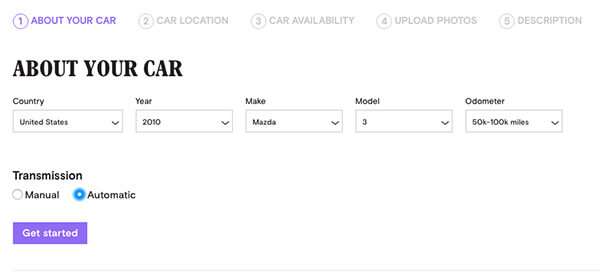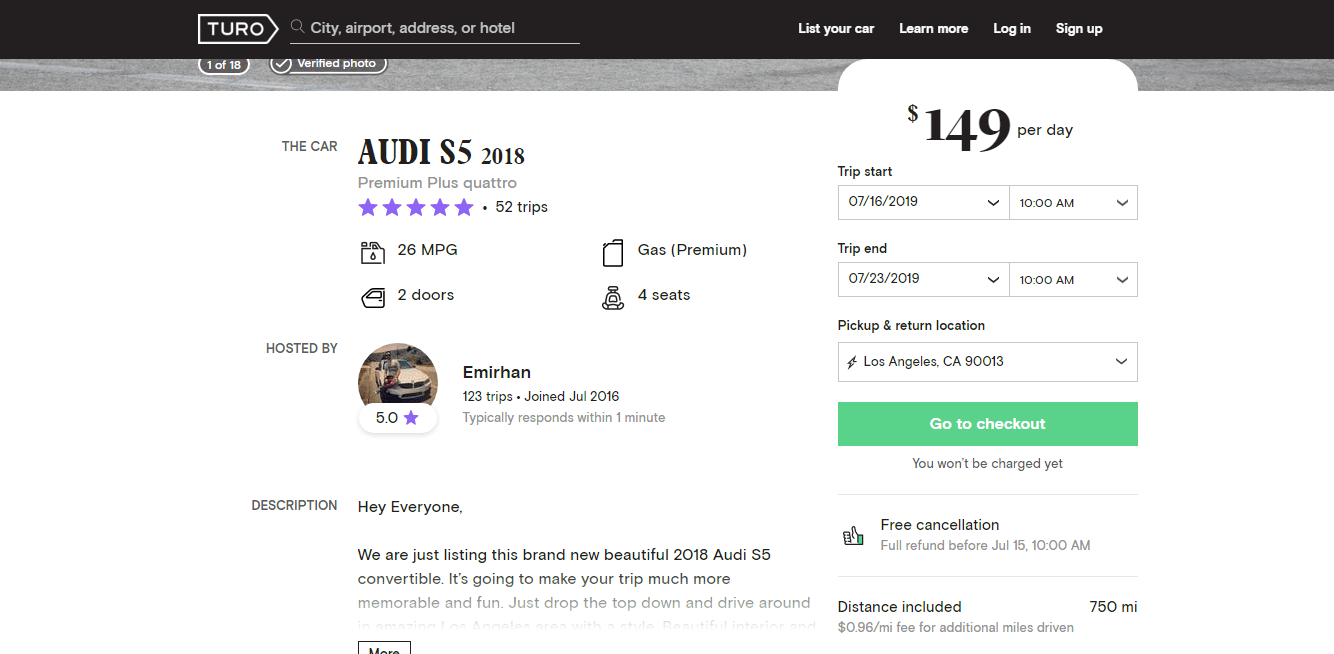It’s no wonder that technology is already shaping the future. While technology has given users more control, it even drives an opportunity and change within the industry. In the rental sector, technology promises to leave no stone unturned. The tech tide is turning the rental market in two significant waves. First, rental car companies themselves are on the phase of changing the value prop facing a customer. In the rental sector, technology promises to leave no stone unturned. The rental market is experiencing a tech-driven shift due to two significant waves. A single change in how bookings are done makes a big difference.
Secondly, technology is transforming car units with digital features that enhance the driving and on-road experience.
And this is how Turo came into the picture. Here a lot of questions will be running in your mind such as ‘what is Turo?’, ‘how does Turo work?’ and many more. Don’t fret! We will answer all your questions right here.
What is Turo?

Founded in 2010, Turo (formerly known as RelayRides) operates as a car rental company based in San Francisco. It is an online marketplace that mainly works on the principle of sharing economy. Turo can be termed as a peer-to-peer car-sharing company, which was formerly known as RelayRides. Turo, formerly known as RelayRides, operates as a peer-to-peer car-sharing company. Here, Turo allows the car owners to rent out their vehicles and make some extra cash out of it. This is a quick and convenient way to rent a car for all those who are in need of transportation.
Contrasting Uber or Lyft, Turo car rental is not a ride-hailing app, rather this service is more equivalent to renting of a traditional car. Hence, it becomes ideal for longer journeys that you can plan in advance, such as exploring new cities at your own pace, going to an upcoming interview, and more.
Turo is a peer-to-peer car-sharing service that connects private car owners with individuals looking to rent vehicles. Unlike traditional rental companies that maintain their own fleet of cars, Turo operates on a decentralized model where private individuals own the cars listed on the platform. This unique approach provides a diverse selection of vehicles and often offers more competitive pricing.
Here are some key aspects that define Turo:
Peer-to-Peer Marketplace
Turo is often compared to Airbnb, but for cars. Just as Airbnb allows homeowners to rent out their properties, Turo enables car owners to rent out their personal vehicles. This model leverages the existing supply of cars, making it easier for people to find a vehicle that fits their needs without the overhead costs associated with traditional rental companies.dyio-=
Diverse Vehicle Options
One of Turo’s major advantages is the variety of vehicles available. Renters can find everything from economical compact cars and practical SUVs to luxury sports cars and vintage classics. This diversity makes Turo an attractive option for different types of renters, whether they need a car for a business trip, a family vacation, or a special occasion.
Personalized Experience
Turo offers a more personalized rental experience compared to traditional companies. Renters often deal directly with car owners, which can lead to more flexible pick-up and drop-off arrangements, personalized recommendations, and a more human touch in the service. Some owners even offer delivery services, bringing the car to the renter’s preferred location.
Cost-Effective Solution
Turo’s peer-to-peer model often results in lower prices compared to traditional rental agencies. Car owners can set competitive prices for their vehicles, and without the need for large fleets and rental locations, Turo can pass those savings on to the renters. Additionally, Turo provides various pricing options, including daily, weekly, and even hourly rates.
Community and Trust
Turo places a strong emphasis on building a trusted community. The platform includes features such as user reviews, detailed car descriptions, and photos to help renters make informed decisions. Both renters and owners are encouraged to leave feedback, which helps maintain a high level of trust and transparency within the Turo community.
In a nutshell, we can even say that Turo is an Airbnb for the cars. To make a note more clear on it, breaking down this amazing car-sharing platform for you.
History and Evolution of Turo
Turo, originally known as RelayRides, was founded in 2010 by Shelby Clark. Inspired by the concept of car-sharing while attending Harvard Business School, Clark envisioned a platform that would allow people to share their personal vehicles, similar to how homeowners share their spaces on Airbnb.
Early Days as RelayRides
RelayRides launched in Boston, Massachusetts, focusing initially on hourly rentals. The platform aimed to provide a convenient alternative to traditional rental services by leveraging the existing supply of privately-owned vehicles. To facilitate this, RelayRides partnered with companies like General Motors to utilize their OnStar technology, enabling remote unlocking and starting of vehicles.
Transition to Peer-to-Peer Model
In 2013, RelayRides made a significant shift from its original model to a peer-to-peer car-sharing marketplace. This change allowed individual car owners to list their vehicles directly on the platform, expanding the range of available cars and making the service more flexible and scalable. This transition marked a turning point, as it enabled the company to grow rapidly and attract a larger user base.
Rebranding to Turo
Recognizing the need for a fresh identity that better reflected its mission and global aspirations, RelayRides rebranded to Turo in 2015. The new name, derived from the Latin word for “to travel,” signified the company’s broader vision of providing diverse and accessible transportation options.
Expansion and Growth
Following the rebranding, Turo expanded its services across the United States and ventured into international markets, including Canada and the United Kingdom. The company focused on enhancing its platform by introducing features such as delivery options, increased insurance coverage, and a more user-friendly app interface.
Key Milestones
- 2016: Turo raised significant funding, including a $47 million Series C round led by Kleiner Perkins, which helped fuel its expansion and technological development.
- 2018: Turo launched in the United Kingdom, marking its first entry into the European market.
- 2019: The platform reached over 10 million members and had over 350,000 vehicles listed globally, highlighting its rapid growth and popularity.
- 2020: Despite the challenges posed by the COVID-19 pandemic, Turo adapted by promoting safer, contactless rental processes and saw increased demand for local travel options.
Present and Future
Today, Turo continues to innovate and expand its services, focusing on improving user experience, expanding its global footprint, and promoting sustainability. The company is exploring new markets and partnerships, aiming to become the go-to platform for car-sharing worldwide.
Turo’s journey from RelayRides to becoming a leading car-sharing marketplace highlights its adaptability and commitment to providing flexible, affordable, and diverse transportation options. As the sharing economy continues to grow, Turo is well-positioned to play a significant role in the future of mobility.
Salient Features of Turo
Turo is packed with features designed to enhance the car-sharing experience for both renters and car owners. Here are some of the most notable features:
Diverse Vehicle Selection
- Variety of Cars: Turo offers a wide range of vehicles, from economical compact cars to luxury sports cars, SUVs, trucks, and even unique vehicles like vintage classics.
- Specialty Vehicles: Renters can find specialty vehicles for specific needs, such as vans for moving, convertibles for a road trip, or electric cars for eco-friendly driving.
Flexible Rental Options
- Hourly, Daily, and Weekly Rentals: Turo provides flexible rental periods to suit various needs, whether it’s a few hours, a day, or an extended trip.
- Long-Term Rentals: For those needing a car for an extended period, Turo offers long-term rental options at competitive rates.
User-Friendly Platform
- Mobile App: Turo’s app is available for both iOS and Android, allowing users to browse, book, and manage rentals on the go.
- Intuitive Interface: The platform is designed to be user-friendly, with easy navigation, detailed car listings, and straightforward booking processes.
Insurance and Protection Plans
- Comprehensive Coverage: Turo provides multiple protection plans for both renters and owners, including liability insurance and physical damage protection.
- Peace of Mind: These plans help ensure that both parties are covered in case of accidents or damages, providing peace of mind during the rental period.
Delivery and Pick-Up Options
- Convenient Delivery: Many car owners offer delivery services, bringing the car to the renter’s preferred location, such as their home, hotel, or airport.
- Flexible Pick-Up: Renters can choose convenient pick-up locations, making the rental process more flexible and user-friendly.
Trusted Community
- User Reviews and Ratings: Both renters and car owners can leave reviews and ratings, helping to build a trusted community and ensure a high level of service.
- Verified Listings: Turo verifies car owners and listings to maintain quality and trustworthiness on the platform.
Advanced Search Filters
- Customizable Searches: Users can filter their search based on various criteria, such as vehicle type, price range, location, and specific features like pet-friendly or all-wheel drive.
- Instant Book: Some listings offer instant booking, allowing renters to secure a car immediately without waiting for owner approval.
Cost-Effective Pricing
- Competitive Rates: Turo’s peer-to-peer model often results in lower prices compared to traditional car rental reviews agencies.
- Discounts and Deals: The platform frequently offers promotions, discounts for longer rentals, and special deals to make renting more affordable.
These features collectively make Turo a leading car-sharing platform, offering convenience, flexibility, and a personalized rental experience that caters to a wide variety of needs and preferences.
How does Turo work?

It starts with the initial registration that is an easy-going process. Once you’ve signed up, you can browse every single detail about the rental cars available near you, just by entering the city or airport, as well as your travel dates.
One feature to definitely draw attention to, the total distance or miles are included over here. Hosts can set up some limits on how many kilometres or miles per day can be driven by their car. Hence, whenever you are in plan for a road trip, all you need to calculate is the distance you are going to travel. The additional mile will incur the charges unless and until an extension is requested by you from the app itself.
Turo especially has three additional classes as mentioned,
Business class, as the name suggests, with the help of this phase, you will be able to have a list of the cars available specifically for business travel.
Deluxe class, it provides some exclusive cars for the guests of the age more than 25. In deluxe class, you can rent a car despite being under the age of 25 but that will come at the cost of a $1500 deposit which is refundable after the ride.
Super Deluxe class, here the one with 30+ age can rent a car. This is the most extraordinary care provided for rent.
For Car Owners
As we know that car owner are the important aspects of Turo business. As a car owner to make your car available for the rent, you will be asked to fulfil the basic requirements, just to be listed for rent on Turo. Few points to be noted to register are vehicles can be hybrid, electric, diesel, or gas. Maximum age of a vehicle is 12 years old and it must have less than 130,000 miles. The value of your vehicle must be up to $150,000. Turo even accepts some classic or speciality vehicles but there are some conditions like must be in excellent condition, should be 1990 or older and it is even subjected to the additional review before acceptance.
In Turo, probably your vehicle would not require any vehicle inspection in the initial phase. But if any complaints are being registered from the renter’s side, then you will be asked to undergo an inspection. Turo will provide you with an inspection form which can be brought to any of the state-certified mechanics.

Some major steps to be followed are,
- Listing of cars
- Responding to the inquiries
- Giving out or delivering your car
- Pick up the car
For Renters
After the easy registration, the renter can choose the delivery location or pick up as per the niches. Depending on the host, here you can purchase various extras whose charge will be included in the final cost. Before you rent a car some of your personal details will be noted for the safety measures.
As a renter, you can choose your Turo Sheild Protection. Turo enables you to choose your insurance from Premium, Basic or Minimum Coverage – each of them has different physical protection. For the payment thing, Turo accepts the online payment through one of the well-known apps available. You will be provided with three option to select your rented car pickup,
- Local Pickup
- Airport Delivery
- City Delivery

Here as a renter, just like Airbnb, you will require a short message to the car owner, where you need to give basic information about your trip. This is one of the important steps to be followed. Once you are done with the booking and is approved, if you haven’t requested to deliver, you will be in need to pick up your car. Take the details of the car from the host.
Turo “Carculator”
The Turo “Carculator” is a tool provided by Turo, a peer-to-peer car-sharing marketplace, that helps car owners estimate the potential earnings they could make by renting out their vehicles on the platform. Here’s a quick overview of how it works:



How to Use Turo’s Carculator
- Enter Vehicle Information: Input details about your car, such as the make, model, year, and location. This information helps Turo estimate the demand and pricing for your specific vehicle in your area.
- Adjust Availability: Specify how often you plan to make your car available for rent. The more days your car is available, the higher your potential earnings.
- Review Earnings Estimate: The Carculator will generate an estimated monthly earning based on your car’s details, location, and availability. This estimate takes into account the average rental price for similar vehicles and local demand trends.
Factors Affecting Earnings
- Vehicle Type: Luxury and unique cars tend to earn more than standard vehicles.
- Location: Cars in high-demand areas or tourist destinations may earn higher rates.
- Availability: More availability generally leads to higher earnings.
- Condition and Features: Well-maintained cars with desirable features (like GPS, sunroof, etc.) can command higher rental prices.
Benefits of Using the Carculator
- Informed Decision: It helps car owners make informed decisions about whether renting out their car on Turo is financially worthwhile.
- Financial Planning: Provides an estimate that can aid in financial planning and budgeting.
- Optimization: Allows owners to see how changes in availability or vehicle upgrades could impact potential earnings.
Using the Turo “Carculator” can give you a realistic idea of the potential income you can generate from sharing your car on the Turo platform.
How does Turo Insurance works?
As we all know that auto insurance always comes into play when driving a vehicle. Turo over here provides some insurance coverage options when you’re driving a car.
Turo offers various insurance options to both hosts (vehicle owners) and guests (renters) to provide protection during a rental period. Here’s a detailed look at how Turo insurance works:
For Hosts
1. Protection Plans
Turo provides several protection plans for hosts, each with different levels of coverage and costs. These plans generally include:
- Liability Insurance: Provides coverage up to $750,000 in the U.S. for bodily injury and property damage claims that occur during the rental period.
- Physical Damage Protection: Covers physical damage to the host’s vehicle up to its actual cash value (up to certain limits) due to an accident or other incidents during the rental.
- Loss of Hosting Income: Compensates hosts for potential loss of income if their vehicle is being repaired due to a covered claim.
- Towing and Roadside Assistance: Offers help in case of breakdowns, flat tires, or other roadside issues during the rental period.
2. Plan Options
Hosts can choose from different plans like the Basic, Standard, and Premier plans, each offering varying deductibles, coverage limits, and earnings percentages:
- Premier Plan: Higher earnings retention with higher coverage, often suitable for hosts seeking maximum protection.
- Standard Plan: Balanced protection and earnings retention.
- Basic Plan: Lower coverage but higher earnings retention.
For Guests
1. Guest Protection Plans
Guests can also select from various protection plans when renting a vehicle on Turo. These plans typically include:
- Liability Insurance: Provides coverage for third-party claims up to a certain limit (varies by plan and location).
- Physical Damage Protection: Covers damage to the rented vehicle during the rental period.
- Deductible: Depending on the plan chosen, guests may have different deductibles (out-of-pocket expenses) for claims.
2. Plan Options
Guest protection plans often come in three tiers: Minimum, Standard, and Premium. Each tier offers different levels of coverage and deductibles:
- Premium Plan: Higher cost but offers the most comprehensive coverage with the lowest deductible.
- Standard Plan: Mid-level cost with moderate coverage and deductibles.
- Minimum Plan: Lower cost with the least coverage and the highest deductible.
How to make your own Ride-Sharing app similar to Uber?
After going through these interesting facts about Turo if you also want to make a similar ride sharing platform then check out BooknRide at an affordable price.
Share your thought with us!
What are your thoughts on our blog “How Does Turo Work?” Did we miss out any point? Let us know in the comment section below.


Helpful information of blog, Thank you for sharing it!